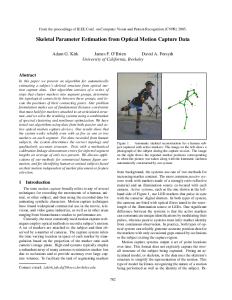Skeletal Parameter Estimation from Optical Motion Capture Data
Abstract
In this paper we present an algorithm for automatically estimating a subject’s skeletal structure from optical mo- tion capture data. Our algorithm consists of a series of steps that cluster markers into segment groups, determine the topological connectivity between these groups, and lo- cate the positions of their connecting joints. Our problem formulation makes use of fundamental distance constraints that must hold for markers attached to an articulated struc- ture, and we solve the resulting systems using a combination of spectral clustering and nonlinear optimization. We have tested our algorithms using data from both passive and ac- tive optical motion capture devices. Our results show that the system works reliably even with as few as one or two markers on each segment. For data recorded from human subjects, the system determines the correct topology and qualitatively accurate structure. Tests with a mechanical calibration linkage demonstrate errors for inferred segment lengths on average of only two percent. We discuss appli- cations of our methods for commercial human figure ani- mation, and for identifying human or animal subjects based on their motion independent of marker placement or feature selection.
Citation
Adam G. Kirk, James F. O'Brien, and David A. Forsyth. "Skeletal Parameter Estimation from Optical Motion Capture Data". In IEEE Conf. on Computer Vision and Pattern Recognition (CVPR) 2005, pages 782–788, June 2005.
Supplemental Material










